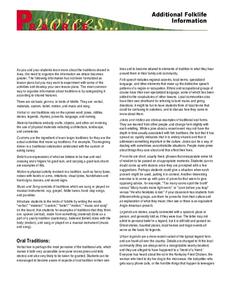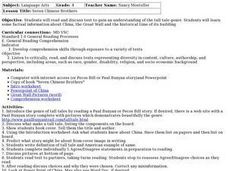Great Schools
Different Types of Writing
What type of writing is this? Learners read a brief introduction to various types of text: instructions, explanations, poems, folk tales, novels, informative, and arguments. The introduction doesn't explain these, so consider going over...
University of Northern Iowa
Additional Folklife Information
Use a packet packed with ideas for how to celebrate the traditions of your country, state, community, and pupils's families. Suggestions for how to draw on oral and material traditions, customs, beliefs, music, and stories all find a...
Curated OER
The Legend of Sleepy Hollow
Young scholars discuss and define folklore, locate town of Sleepy Hollow, NY, on map, calculate distance from Sleepy Hollow to their school, if applicable, review vocabulary list from The Legend of Sleepy Hollow, read story aloud, and...
Pennsylvania Department of Education
Comparing Key Ideas and Details in Fiction and Nonfiction
Students recognize the differences between fiction and nonfiction texts. In this genre study lesson, students discuss what nonfiction means and write the definition. Students listen to a read aloud and vote whether the text is fiction or...
Curated OER
Tall Tales Today
Students explore the attributes of American tall tales. In this folklore lesson plan, students read several tall tales, describe the elements of tall tales, and then use hyperbole to write their own tall tales.
Curated OER
Tell Me a Whopper!
Sixth graders investigate tall tales as a literary genre. They listen to a number of tall tales to discover how exaggeration is used as a story element. They write and publish a tall tale using word processing software. They illustrate...
Curated OER
"Knot" the Whole Truth: Writing a Modern-Day Story with a Tall Tale's Voice
Beyond Paul Bunyan and his blue ox, tall tales can be a great way to teach young writers about word choice and voice in their writing. Using Jerry Spinelli's Maniac Magee and the Six-Trait Writing process, they begin to write their own...
Curated OER
Heroes
Learners read the story of Paul Bunyan and identify the characteristics and actions that make him a hero. In this heroes lesson plan, students explain their answer and draw pictures.
Curated OER
Humorous Solutions
Discover with your class the humorous solution that follows tall tales. Elementary learners will discuss the tall tale Paul Bunyan and give ordinary solutions for the problems in the story. They will read Sally Ann Thunder Ann Whirlwind...
Curated OER
Exaggeration
Students read the tall tale of Pecos Bill and identify an exaggeration in the story which they state as being part of a tall tale. In this exaggeration lesson plan, students identify the exaggeration by drawing a picture.
Curated OER
Tradition through storytelling and music
Students discover how storytelling can shape a person's tradition.Students examine different methods of storytelling such as music, biographies, and African folktales. They then demonstrate their knowledge of storytelling by writing...
Curated OER
Guided Reading with Ten Oni Drummers
Second graders read the book, Ten Oni Drummers. Working in guided reading groups, they discuss fantasy as a genre and preview the book. They review word identification strategies and read the book silently. After reading, they confirm...
Curated OER
Identifying Differences Between Fiction and Nonfiction Books
Students explore the differences between fiction and non-fiction book. In this genre study instructional activity, students read examples of fiction and non-fiction and identify the characteristics of each genre. Students list the...
Curated OER
Being in the Noh: An Introduction to Japanese Noh Plays
Students analyze the conventions used in Noh plays and write an introduction to a Noh play of their own. In this Noh play lesson, students identify the conventions of the Noh form and analyze the realizations the main character achieves....
Curated OER
Letter From a Folklorist
In this letter from a folklorist worksheet, students read a letter from a folklorist to discover more about this career. The letter describes the importance of this field and aspects of the job.
Curated OER
Connecting Families through Folk Stories and Fairy Tales
Students engage their families to write down a folk story from their primary language. In this family literacy activity, students rewrite the story or fairy tales in English. Parents and students are invited to present the stories in...
Curated OER
Tall Tales
Students are provided with an opportunity to explore not only the interface but also the variety of scenery and objects available on the program. Younger students may require additional teacher assistance during the computer activity.
Curated OER
Fables and Trickster Tales Around the World
Young scholars analyze fables and trickster tales from various cultural traditions. In this fable analysis lesson, students identify the elements of fables and trickster stories. Young scholars read Aesop's fables and Ananse spider...
Curated OER
The Eight Immortals
Students compare and contrast the Eight Immortals with American super-
heroes, such as Superman, Wonder Woman, and Aquaman while examining the literary genre of folktales and its connection to art.
Curated OER
Seven Chinese Brothers
Fourth graders identify the characteristics of a tall tale. They read "The Seven Chinese Brothers" and analyze it for these characteristics. Students complete a comprehension worksheet and discuss why "The Seven Chinese Brothers" can be...
Curated OER
Sequencing a Chinese Folktale
Students sequence the events of the popular Chinese folktale "The Terrible Nung Gwama" using a graphic organizer. This lesson takes 45-minutes and includes two possible enrichment activities.
Curated OER
China: Land Beyond the Wall
An excellent series of five lessons on China awaits you and your young geographers. In these lessons, learners engage in hands-on activities, watch streamed video, access websites, and complete activities in cooperative groups in order...
Curated OER
Analyzing the Use of Irony in a Short Story
Ninth graders examine how literature connects to real-life and see how irony aids in the development of theme. They read Shirley Jackson's The Lottery, and discuss elements of foreshadowing and situational irony. Then learners will write...
Curated OER
Fieldwork Basics Overview
Put your feet up and grab a cup of coffee before going through this extensive field work unit plan! Based on folklorist studies of traditional culture and ethnography, several activities focus on topics such as cultural sensitivity;...

























